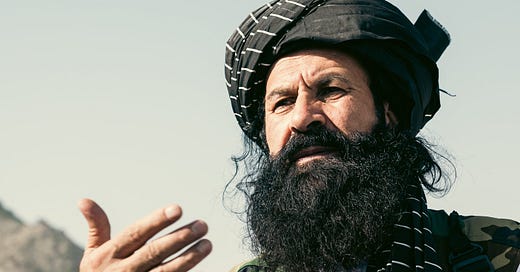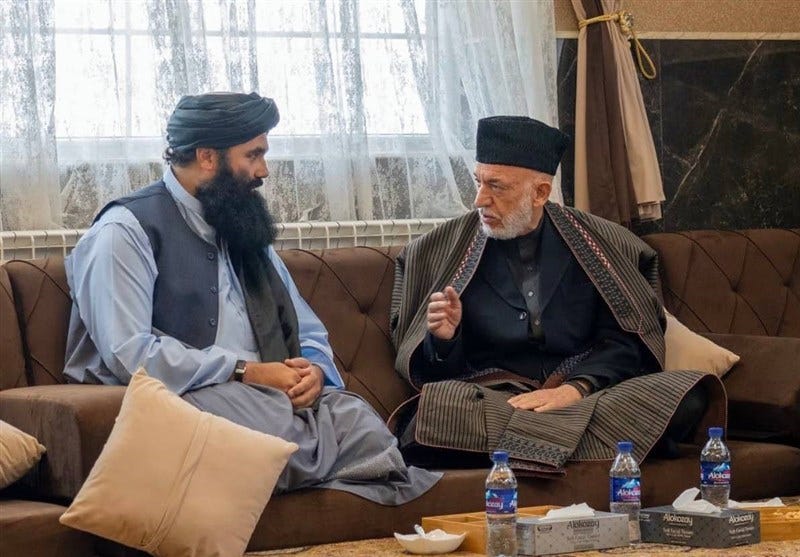Senior Taliban figure assassinated: who was Khalil Haqqani?
And why his death suggests internal divisions within the regime.
Note: The opinions expressed in this article are solely those of the author and do not necessarily reflect those of other involved parties.
To read this article in French:
“Our war was with foreigners; we were never at war with Afghans, nor will we ever be”.
Those were the words of Khalil Rahman Haqqani, a senior Taliban official and pivotal figure in Afghanistan's recent history, who was reportedly killed in a suicide bombing inside an Interior Ministry mosque, on December 11. This was the first attack against a government minister since the return to power of the Taliban. The Islamic State Khorasan Province (ISIS-K) has claimed responsibility for the attack, but analysts suggest internal divisions within the Taliban might have played a role in his death.
Haqqani, also known as Khalil Haji, was the minister for Refugees and Repatriation in the Taliban regime, and the brother of Jalaludin Haqqani, founder of the notorious Haqqani network and a leading military commander in his organisation’s holy war against the Soviet Union. His nephew, Sirajuddin Haqqani, is the current Taliban interior minister and one of the most influential figures in the Islamic Emirate's leadership structure.
A member of the Zadran clan, within the Ghilji Pashtun tribe in Afghanistan’s Paktia province, Khalil Haqqani gained renown for his courage and technical prowess during the Soviet-Afghan war. Young fighters revered him for his battlefield expertise, particularly his skill with rocket launchers.
Decades later, in August 2021, he was the first person to enter Kabul on the day of its fall. In the days prior, he had maintained communication with the then-Republic’s National Security Advisor, Hamdullah Mohib. The last phone call made from the deposed government was between the two of them. In that conversation, as he later emphasised in an interview with Shamshad TV, Haqqani assured Mohib that the lives and property of Republic officials would be safe, making it his responsibility to protect them. After the Taliban took the Afghan capital, Haqqani indeed personally oversaw the security of prominent figures like former president Hamid Karzai, who ruled the country until 2014.
Deep divisions within the Taliban
An authoritative figure, Haqqani was the subject of extensive security protocols, so his death unsurprisingly raised questions and suspicions.
Recovered CCTV footage reportedly shows the suicide bomber, a man with a broken arm in a sling, around where the explosives were allegedly concealed. Yet, given the tight security surrounding Khalil Haqqani, it isn’t clear how the bomber was able to reach inside the ministry.
Therefore, while ISIS-K’s claim of responsibility aligns with its ongoing campaign against Taliban officials, the attack has fueled speculation of internal power struggles within the Islamic Emirate. Haqqani’s death underscores the volatile political landscape in Afghanistan and the challenges facing Taliban leadership as they navigate governance amid factional divides.
In early December, the Taliban leader, Hibatullah Akhundzada, held a closed-door meeting in Kandahar with government officials, including cabinet members, to address internal disputes. Although no official statement was issued by Akhundzada’s office, key sources reported that the evening concluded without resolving the tensions. During the meeting, Khalil Haqqani allegedly made strongly-worded remarks to the leader, an uncommon occurrence in the otherwise hierarchical and deferential structure of the group. Just days later, he was dead. During his funeral, the Taliban’s Foreign Minister reportedly alluded to those remarks.
A former spokesperson for the Taliban’s armed forces alleged on X that Haqqani had been under consideration for a position in a proposed transitional government. He further claimed that Haqqani fell victim to internal conspiracies ‘between Kabul and Kahandar’. Kandahar is the historical power base of the Taliban’s supreme leader, Hibatullah Akhundzada, while Kabul is the stronghold of Sirajuddin Haqqani, the powerful interior minister. The Taliban Prime Minister’s office and the central cabinet also operate out of Kabul. Both power centers have their supporters and factions within the government and military.
Credible sources, both directly to me [Noorwali Khpalwak, NDLR] and on social media, have confirmed the existence of deep fractures between Kandahar and Kabul. While the Taliban strongly denies any internal discord, these denials have only intensified suspicions.

An alternative for Afghanistan?
Sirajuddin Haqqani, the Taliban interior minister and de facto second most powerful figure in the country, recently made a series of strategic trips. After the lifting of his UN travel ban, he travelled to the United Arab Emirates twice, and reportedly met with the ruler of Abu Dhabi, Sheikh Mohammed bin Zayed Al Nahyan, widely known as MbZ. These visits attracted significant attention, especially as the UAE is currently home to Afghanistan’s exiled former president, Ashraf Ghani.
In his speeches, Sirajuddin Haqqani repeatedly criticised the current Taliban leadership’s policies, and called for reopening schools to girls. At home and abroad, this stance earned him a reputation as a moderate figure within an otherwise hardline regime. After performing the Hajj pilgrimage to Mecca, Haqqani also held talks with Saudi officials, reportedly discussing Afghan affairs.
Haqqani’s international travel, made with permission from the United Nations, helped elevate his standing. A recent New York Times profile shed light on his activities and positioning, leading to increased scrutiny of his role within the Taliban and his potential influence on Afghanistan’s future.
Back in Afghanistan, Sirajuddin Haqqani drew attention with the holding of a memorial ceremony for his assassinated uncle, Khalil Rahman Haqqani. The event, held at the younger Haqqani’s newly-built villa in Paktia province, was remarked for its scale but also for its political undertones.
The estate, reportedly spanning 100,000 square meters, was completed in mid-2024 at a cost exceeding $2 million. Photos shared on Sirajuddin’s X page showcase the villa's opulence, with Italian furniture, Arabic mattresses, Afghan handwoven silk carpets, modern electrical appliances, security cameras, and large Japanese generators.
The guest list included key figures from Afghanistan’s past, including those alongside whom Khalil Haqqani fought for twenty years, killing thousands. Former President Hamid Karzai traveled to Paktia to personally offer his condolences.
President Karzai had just returned to Kabul after meetings with officials from Germany, the United Kingdom, Turkey, and the United Arab Emirates. The former president also discussed the start of intra-Afghan talks with Afghan political leaders in exile, including former governor of Paktia province Mohammad Halim Fidai.
Notably absent, however, was Taliban leader Hibatullah Akhundzada, whose decision to skip the ceremony further fueled speculation about ongoing rifts within Taliban leadership.
In discussions with Kabul Podcast, prominent Afghan figures, including Mohammad Mohaqiq, leader of the ethnic Hazara Wahdat-e-Islami party, and Umer Daudzai, a former Interior Minister, emphasized the need for dialogue. Mohaqiq highlighted the growing consensus among Afghan politicians that political solutions, not conflict, are the way forward. This sentiment aligns with the recently formed “National Assembly for the Salvation of Afghanistan,” a coalition of Republican party leaders and civil society members advocating for dialogue and reconciliation.
And some hope Sirajuddin Haqqani could be the face of that other Afghanistan.
According to Mr. Rahmatullah Nabil, a former Afghan security chief, “Sirajuddin Haqqani is on the path to becoming Afghanistan’s al-Jolani” - referring to the once-leader of the Syrian extremist group Jabhat al-Nusra, who rebranded himself as a pragmatic figure after overthrowing Bashar al-Assad’s regime and bringing his Sunni militia group, HTS, to power.
Like al-Jolani, Sirajuddin’s actions and rhetoric indeed suggest he may be positioning himself as a more moderate and reformist figure within the Taliban, engaging with Western diplomats and journalists.
Given the marked geopolitical changes underway in the region, and new players coming to the fore, this perspective might be more than a distant hypothetical.
Even Trump talks about ending wars, and regime changes have been known to trigger domino effects. If the current model in Syria proves applicable and the international community cooperates, this version could succeed in the region, especially in Afghanistan, where Sunni dominance prevails. Only time will tell.
Noorwali Khpalwak is an Afghan journalist and editor with more than ten years’ experience. He was Media Commissioner then Chief of Staff at the independent Afghan Electoral Commission. He then supervised the National Assembly’s media strategy as Director of Information.
As a journalist, he produced and presented political programmes for Spogmai Radio and Kabul News TV, the country’s leading 24-hour news channel. Fleeing Afghanistan in 2021, after the fall of the capital, he arrived in France where he now continues to develop his podcast, ‘Kabul Podcast’, to keep bringing independent information and a space for expression to Afghans.
This article was edited with support from Daria Timchenko.











